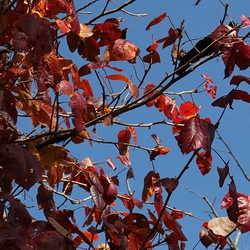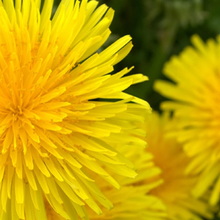(Editor's Note: This article was originally published on March 18, 2008. Your comments are welcome, but please be aware that authors of previously published articles may not be able to promptly respond to new questions or comments.)
Virginia creeper (Parthenocissus quinquefolia) [shown at right] does indeed bear a resemblance to poison ivy (Toxicodendron radicans) [shown below]. It is more often mistaken for it than any other plant.

Both are woody vines with a strong climbing habit, both have similar brushy aerial roots for clinging to the bark of trees, both are deciduous with leaves that turn red in the fall. And while Virginia Creeper has five leaflets as opposed to the notorious "leaflets three" of poison ivy, it is common for early-sprouting leaves of Virginia creeper to have only three leaflets, exacerbating the confusion. Both plants produce berries that are attractive to birds, which then propagate the plant widely via their droppings. And worst of all, both plants flourish in woodsy habitats, so that it is quite possible to find them growing together in the same thicket or climbing the same trees, and both are difficult to eradicate once established.
There are several ways to tell the two vines apart, however. Virginia creeper's leaves are "toothier," longer, and more folded along the midrib, with rather more prominent veins. The leaflets of poison ivy are carried on petiolules (stems), with the central petiolule longer than the rest; the leaflets of Virginia Creeper sprout directly from the stem, without distinct petiolules. The berries of Virginia creeper are dark purple, while poison ivy's are white.
The reason for the urgency in distinguishing these two plants is of course the fact that poison ivy produces a toxin called urushiol that is seriously harmful to most people. Virginia creeper, however, is not entirely harmless, as it contains oxalic compounds to which some people are allergic; they may end up with a rash from attempting to remove these vines.
This reaction is one indictment against Virginia creeper. The other is its invasive habit of growth. Now there are some people who insist that the term "invasive" properly applies only to non-native plants in a given habitat. In that case, Virginia creeper can not be labeled invasive in the eastern half of the U.S., where it is native. (So, for that matter, is poison ivy.) But it must certainly be considered aggressive. Virginia creeper's growth can be very vigorous. The vines can grow twenty feet in the course of a single year, and they readily take root at stem nodes along the length of the vine, where new shoots then sprout.
But Virginia creeper really prefers to grow upwards. The plant tolerates shade and can often be found growing beneath trees, but it reaches high for the sunshine. Any time the vine encounters a tree, it begins to climb, anchoring itself into the bark with adhesive pads at the ends of its aerial roots. The vines can reach at least 50 feet in length. It can climb just about any vertical surface: telephone poles, fences, walls. I have some of it covering the side of my metal shed. Left unchecked, Virginia creeper vines have the potential to overwhelm their host tree, but they are less of a problem than, say, kudzu or wild grapevine.

On the positive side, there are many gardeners who appreciate its habits, who want a vigorous climber to cover fences or walls, if not necessarily the trunks of trees. Virginia creeper gets points for being a native plant and for its berries as a source of food for birds (although they can be toxic if ingested by humans). And many people enjoy the bright red color of its foliage in the early fall.

I come down myself on the cautiously positive side. While I have never actually planted Virginia creeper, I have encouraged it in some places as a groundcover. My property is bordered by a long row of junipers, where a lot of really obnoxious weeds had a tendency to sprout - buckthorn, ground ivy, garlic mustard - as well as Virginia creeper. I soon noticed that the Virginia creeper vines outcompeted most of the rest, and I encouraged them to spread the length of the row. Of course they try to spread elsewhere, as well, so that I have to go down the row every year and pull them out of the trees, where they really want to grow. Elsewhere, I try to pull them out if I see them sprouting. Young vines are relatively easy to uproot if you spot them early, and I rarely have to resort to the Brush-Be-Gone. And I would definitely rather have Virginia creeper than poison ivy!
















